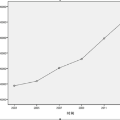Mobile technology enables unprecedented continuous monitoring of an individual's behavior, social interactions, symptoms, and other health conditions, presenting an enormous opportunity for therapeutic advancements and scientific discoveries regarding the etiology of psychiatric illness. Continuous collection of mobile data results in the generation of a new type of data: entangled multivariate time series of outcome, exposure, and covariates. Missing data is a pervasive problem in biomedical and social science research, and the Ecological Momentary Assessment (EMA) using mobile devices in psychiatric research is no exception. However, the complex structure of multivariate time series introduces new challenges in handling missing data for proper causal inference. Data imputation is commonly recommended to enhance data utility and estimation efficiency. The majority of available imputation methods are either designed for longitudinal data with limited follow-up times or for stationary time series, which are incompatible with potentially non-stationary time series. In the field of psychiatry, non-stationary data are frequently encountered as symptoms and treatment regimens may experience dramatic changes over time. To address missing data in possibly non-stationary multivariate time series, we propose a novel multiple imputation strategy based on the state space model (SSMmp) and a more computationally efficient variant (SSMimpute). We demonstrate their advantages over other widely used missing data strategies by evaluating their theoretical properties and empirical performance in simulations of both stationary and non-stationary time series, subject to various missing mechanisms. We apply the SSMimpute to investigate the association between social network size and negative mood using a multi-year observational smartphone study of bipolar patients, controlling for confounding variables.
翻译:翻译结果:
标题:
状态空间模型的多重插补方法用于不稳定的多元时序缺失数据,在数字精神病学中的应用
摘要:
移动技术使得对一个人的行为、社交交互、症状和其他健康状况的连续监测成为可能,这是治疗进步和有关精神疾病病因的科学发现的前所未有的机遇。移动数据的连续收集产生了一种新的数据类型:纠缠的多元时序结果、暴露和协变量。在生物医学和社会科学研究中,缺失数据是一个普遍存在的问题,而在精神研究中使用移动设备进行生态短时评定 (EMA) 更加不例外。然而,多元时序的复杂结构在处理缺失数据时引入了新的挑战,以进行适当的因果推断。数据插补通常被推荐用于增强数据效用和估计效率。大多数可用的插补方法要么设计用于纵向数据,但具有有限的跟踪时间,要么设计用于稳态时间序列,这与可能的非稳态时间序列不兼容。在精神学领域,非稳态数据经常遇到,因为症状和治疗方案可能随时间发生剧烈变化。为了解决可能的非稳态多元时序数据的缺失数据,我们提出了一种基于状态空间模型 (SSMmp) 的新颖的多重插补策略和一个更加计算效率更高的变体 (SSMimpute)。通过评估它们在各种缺失机制下的理论性质和实证表现,我们展示了它们优于其他广泛使用的缺失数据策略的优点。我们将SSMimpute应用于一个多年的双相患者观察性智能手机研究中,控制混杂变量,以研究社交网络大小与负面情绪之间的关联。



